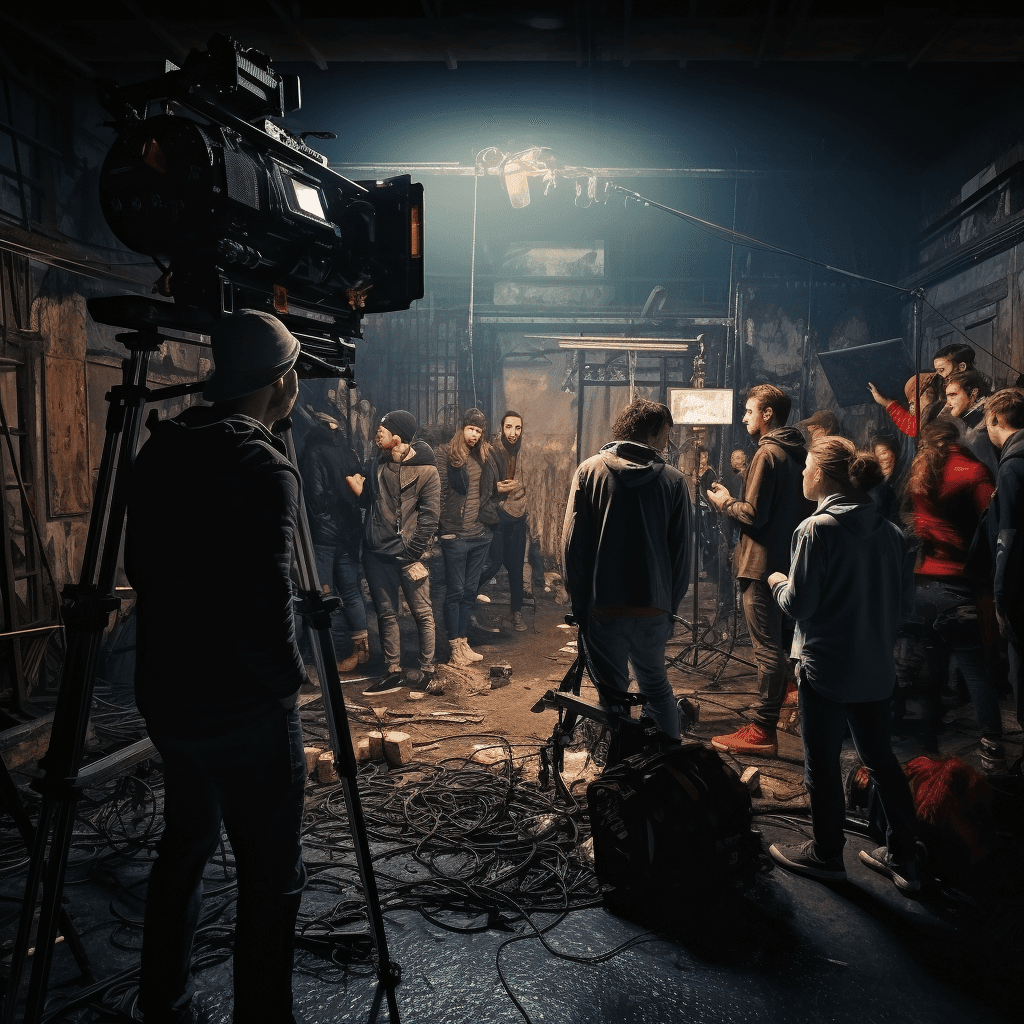
What's After the Blog?
Production • Awards
The Journey of a Film: From Script to Screen to Awards
Dive into the captivating journey of a film from script to screen to awards, exploring the collaborative process, challenges, and triumphs that shape cinema's most memorable movies.
January 27, 2024

Movies mentioned in this article
The Journey of a Film: From Script to Screen to Awards
Introduction: The Birth of a Movie Idea
The inception of a movie begins with a single idea, a spark of creativity that eventually grows into a full-fledged script. This genesis can come from various sources - an adaptation of a novel, a historical event, a personal experience, or even a burst of inspiration. For example, the movie Inception began with Christopher Nolan’s fascination with the concept of dream manipulation. Similarly, historical events inspired films like Schindler’s List and The King’s Speech, while personal experiences influenced movies such as Lady Bird and 8 Mile.
Screenwriting is more than just penning down dialogues; it’s an art of weaving a narrative that resonates with audiences. It involves constructing compelling characters, intriguing plots, and immersive settings. A script serves as the backbone of a film, guiding every aspect of production. The transformation of this script from paper to screen involves numerous revisions and collaborations. Famous screenplays like Pulp Fiction by Quentin Tarantino and The Social Network by Aaron Sorkin underwent multiple drafts to refine their stories and dialogues. These scripts are not just words on a page; they are blueprints for creating cinematic magic.
From Pen to Production: The Script’s Journey
Once a script is finalized, the next step is to attract producers and get the film green-lit. This phase is crucial as it determines whether a script will come to life on screen. The journey from a screenplay to a film involves pitching to studios or independent producers. A script must not only be compelling but also marketable. The success of movies like Get Out and Parasite demonstrates how unique, well-crafted scripts can attract producers and captivate audiences worldwide.
How does a screenplay get noticed by a producer? This process varies, but it often involves script agents, pitch meetings, and screenplay competitions. A well-written script that offers something unique and engaging has a higher chance of being picked up. For instance, the script for Juno gained attention for its distinctive voice and was eventually produced due to its originality and emotional depth. Networking and industry connections also play a significant role. Screenwriters often attend film festivals and pitch events to showcase their work, hoping to catch the interest of a producer who sees the potential in their story.
The transition from script to screen is a collaborative and often complex process. It involves input from directors, producers, and sometimes even actors who may have their vision for the film. This collaboration can lead to significant changes from the original script, adapting and evolving the story to suit the screen. Classic examples of such collaborations include the making of The Godfather, where Francis Ford Coppola and Mario Puzo worked closely to adapt Puzo’s novel, and Titanic, where James Cameron’s vision transformed the screenplay into a cinematic masterpiece. The journey from script to screen is a testament to the collaborative nature of filmmaking, where various creative minds come together to bring a story to life.
Pre-Production: The Blueprint of the Film
Pre-production is where the vision for the film starts taking a tangible shape. This stage is akin to laying the foundation of a building – it involves meticulous planning and decision-making that will dictate the entire filming process. Key elements in this phase include casting, location scouting, budgeting, and storyboarding. The casting process is critical as the actors breathe life into the characters from the script. Iconic casting decisions, like choosing Heath Ledger for the Joker in The Dark Knight or Vivien Leigh as Scarlett O’Hara in Gone with the Wind, have significantly influenced the success and legacy of these films.
Location scouting involves finding the perfect settings to bring the script to life. Directors and cinematographers work closely to choose locations that align with the film’s visual narrative. The choice of location can add an authentic touch to the film, as seen in Lord of the Rings, where New Zealand’s landscapes brought Middle Earth to life. Budgeting is another crucial aspect, as it impacts every decision in the filmmaking process. It involves allocating funds for various departments, ensuring the best use of resources to realize the director’s vision.
Storyboarding is the final piece of the pre-production puzzle. It involves creating visual representations of scenes, guiding the filming process. Directors like Alfred Hitchcock and Guillermo del Toro are known for their detailed storyboards, which serve as a visual script for the film. These storyboards are critical for complex scenes, as they provide a clear guide for the crew during production. Pre-production is a phase where the film starts to move from concept to reality, setting the stage for the magic of production to begin.
Lights, Camera, Action: The Filming Process
The filming process, or production, is where the script and pre-production plans come to life. It is the most intense and dynamic phase of filmmaking, involving a synergy of various elements and creative inputs. The director, along with the cast and crew, work tirelessly to capture the essence of the script through their performances, cinematography, and set design. Each day on set is meticulously planned, with scenes often shot out of sequence due to logistical considerations. This requires actors and directors to have a firm grasp on the story’s overall arc and emotional continuity.
What are the biggest challenges faced during film production? Film production is fraught with challenges, ranging from managing the dynamics on set to dealing with unexpected weather conditions. For example, the filming of The Revenant faced numerous challenges, including harsh weather conditions and remote locations, testing the resilience of the cast and crew. Technical difficulties, such as equipment malfunctions, can also pose significant challenges, as seen in the complex production of Gravity, where innovative filming techniques were used to create the illusion of zero gravity.
The relationship between the director and actors is crucial during this phase. Directors like Martin Scorsese and Steven Spielberg are known for their ability to extract powerful performances from actors, elevating the film’s impact. The chemistry between actors also plays a vital role in bringing authenticity to the characters’ interactions. Iconic scenes, like the improvised conversation in the taxi in Taxi Driver, showcase how actors’ performances can profoundly affect a film’s final outcome. The production phase is a whirlwind of creativity and challenges, where the collective efforts of the cast and crew transform the written script into a cinematic reality.
Post-Production: Crafting the Final Product
After the completion of the filming process, the film enters post-production, a stage where it truly comes together. This phase is where the raw footage is transformed into a cohesive narrative through editing. Editing is an art form in itself, often referred to as the “invisible art” because its best work goes unnoticed by the audience. Editors like Thelma Schoonmaker, who frequently collaborates with Martin Scorsese, play a pivotal role in shaping the film’s rhythm and pace. The impact of editing can be seen in films like Whiplash, where rapid cuts and rhythmic editing enhanced the movie’s intensity.
Sound design and music also play integral roles in post-production. They add depth and dimension to the film, often becoming characters in their own right. The eerie soundtrack of Jaws or the haunting score of Interstellar exemplify how music can amplify the emotional impact of a film. Sound effects and mixing contribute to the film’s realism and immersion. The groundbreaking sound design in Saving Private Ryan, for instance, brought the harrowing reality of war to the audience.
Visual effects (VFX) have become an increasingly important aspect of post-production, especially in genres like sci-fi and fantasy. Movies like Avatar and The Lord of the Rings showcase the incredible potential of VFX in creating immersive worlds and characters. However, the goal of VFX is not always to stand out; often, it’s used subtly to enhance the film’s realism, as seen in the historically detailed sets of The Grand Budapest Hotel. Post-production is the final step in the journey of a film’s creation, where all elements come together to form the movie that audiences will eventually see.
The Marketing Machine: Promoting the Film
Once a film is completed, the focus shifts to marketing and distribution – crucial steps that determine a film’s success at the box office and beyond. The marketing of a film involves creating a strategy to attract its target audience, often starting months before the film’s release. This includes the creation of trailers, posters, and social media campaigns, all designed to build hype and anticipation. Trailers, in particular, are an art form; they must intrigue the audience without revealing too much. The trailers for movies like Inception and The Social Network were highly effective in piquing interest while keeping the plot under wraps.
Social media campaigns have become an increasingly important tool in film marketing. They allow for direct engagement with the audience, creating a sense of community and anticipation. For example, the marketing for Deadpool utilized social media to great effect, with viral posts and videos that captured the film’s irreverent tone. Film festivals and screenings also play a role in marketing, especially for independent films. They provide a platform for critical acclaim and word-of-mouth promotion, as seen with Moonlight, which gained momentum through the festival circuit.
Distribution is the final piece of the puzzle, involving the logistics of getting the film to theaters and, more recently, streaming platforms. The choice of distribution channels can significantly impact a film’s reach and profitability. The rise of streaming services like Netflix and Amazon Prime has opened new avenues for film distribution, providing filmmakers with alternative ways to reach audiences globally. The marketing and distribution phase is where the film’s journey to the audience is completed, setting the stage for its reception and legacy.
The Road to the Red Carpet: Film Festivals and Awards
The journey of a film often culminates in the glitz and glamour of film festivals and award ceremonies, where it receives recognition and acclaim. Film festivals like Cannes, Sundance, and Toronto International Film Festival are pivotal for many films, serving as platforms for exposure, critical acclaim, and distribution deals. These festivals are not just about showcasing films; they are breeding grounds for networking, where filmmakers, producers, and distributors come together. Movies like Whiplash and Slumdog Millionaire gained significant momentum and attention after their success at film festivals, catapulting them onto the global stage.
The awards season is another critical phase in a film’s journey, with the Academy Awards, Golden Globes, and BAFTAs being some of the most coveted accolades. Winning or even being nominated for these awards can significantly enhance a film’s visibility and legacy. For instance, The Shape of Water’s Oscar win for Best Picture boosted its recognition and acclaim. However, the road to these awards is not just about the quality of the film; it often involves strategic campaigns by studios to promote their films to voters. The importance of these awards lies not only in the recognition of artistic and technical excellence but also in their ability to influence a film’s place in cinematic history.
Conclusion: A Film’s Legacy and Impact
The journey of a film from script to screen to awards is a testament to the collaborative effort of countless individuals, each contributing to the creation of a cinematic piece that can entertain, inspire, and even change perspectives. The success and legacy of a film are not solely measured by box office numbers or awards but also by its impact on audiences and its contribution to the art of cinema. Films like The Godfather, Star Wars, and Forrest Gump have left indelible marks on popular culture, influencing not just the film industry but society at large.
Each film’s journey is unique, with its own set of challenges and triumphs. This journey reflects the ever-evolving landscape of cinema, where new technologies, storytelling techniques, and changing audience preferences continually redefine what makes a film successful. As viewers, understanding this journey enhances our appreciation of the films we love and the art form itself.
Eager for more insights into the magical world of movies? Explore more articles and behind-the-scenes stories on our ATM Blog!
Continue reading

What's After the Movie?
Not sure whether to stay after the credits? Find out!
Check out our other apps:
Actors
Companies
Latest Movies
© 2025 What's After the Movie. All rights reserved.

































